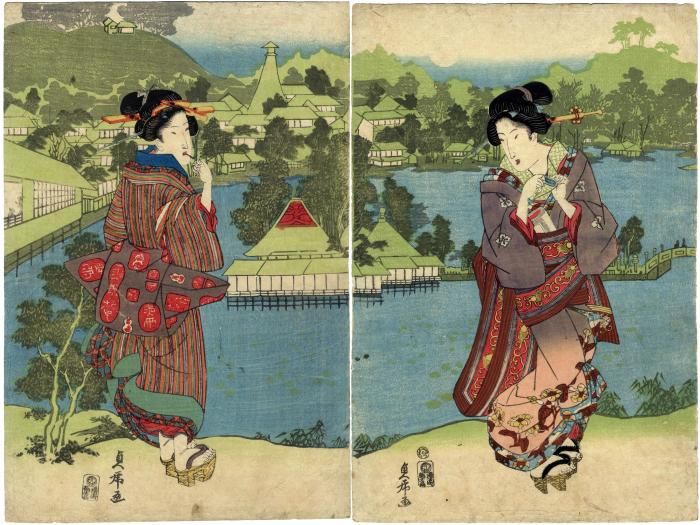Utagawa Sadatora (歌川貞虎) (artist )
A Moonlit Night at Shinobazu Pond (不忍池月夜) - the center and left-hand panels of a triptych
1830s
20.25 in x 15.25 in (Overall dimensions) Japanese woodblock print
Signed: Sadatora ga (貞虎画)
Publisher: Tsuruya Kiemon
(Marks 553 - seal 22-006)
Censor's seal: kiwame
Google maps - Shinobazu Pond, Tokyo
Mead Art Museum at Amherst College - left-hand print listed as being by Sadafusa Shinobazu Pond
"...Shinobazu Pond in Ueno, is an area that was famous in Edo for its scenic beauty and that in the eighteenth century also happened to be a center of scholarly and literary publishing and print culture. The neighborhood was also known for its many established pharmacies and shops selling trend-setting handicraft items and for numerous "meet up" teahouses where clients could connect with prostitutes. [The two women in this print appear to be married by the way they are wearing their obi.] It was thus an area in which the cultured and the bawdy mingled..."
Quoted from: The Akita Ranga School and The Cultural Context in Edo Japan by Imahashi Riko, pp. 23-24.
In a 1682 publication, Murasaki no hitomoto (A Sprig of Purple), about things to see in the Edo area, it says: "There is an island int he pond, with a shrine to Benzaiten. It was built by Mizunoya Ise no kami. An islet is located to the south of the island. There a man called Kangakuin Daisuke, a merchant dealing in [general purpose medication] constructed three copper-tiled sutra halls that store the Issaikyo [complete collection of sutras]. This island is lovely; the scene is attractive. Pine trees grow there, and there is always a breeze. The refreshing cool of the water, which makes one forget to return home at sunset in summer, is even more pleasant than the view beside the flowers." (Ibid., p. 99)
****
Despite the overall beauty of this diptych there are often small, overlooked details. For example, the woman on the left appears to be using a toothpick, as though these two have just come from having a tasty lunch or snack. This height overlooking Shinobazu Pond was known to have a number of popular restaurants and tea houses.
Also, you might compare the differences in the geta these women are wearing. The differences in the straps is striking and a nice, but unnecessary touch. The obi of the woman on the right is decorated with stylized dragons in an almost abstract form - a very ancient motif originating in China - while the obi of the woman on the left is covered with reproductions of seals, some of which are formed in an ancient script.
Tsuruya Kiemon (鶴屋喜右衛門) (publisher)
beautiful woman picture (bijin-ga - 美人画) (genre)
landscape prints (fūkeiga 風景画) (genre)
